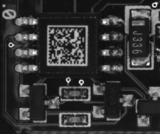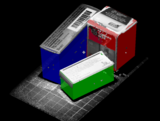
HALCON 19.11
Deep Learning Anomaly Detection

Automated surface inspection is an important task in many manufacturing industries and deep-learning-based solutions are becoming a standard tool which can be used to distinguish parts, detect and segment defects. However, it is often not easy to get enough images of the defect or the effort of labeling the available data is very high.
HALCON's new Anomaly Detection feature gives you the possibility to perform an inspection using only a relatively low number of "good" images for the training. The inference results in the "anomaly" that was detected in the inspected image compared to the trained images. On the right, you can see an example of a defective bottleneck.
ECC 200 Code Reader Speedup

In HALCON 19.11, the code reader for ECC 200 codes has been significantly accelerated for multi-core systems. The biggest improvement was achieved for codes that are particularly hard to detect and read. For such codes a speedup of about 200% can be achieved. This speedup also greatly increases the viability of embedded-based code readers by making optimum use of existing hardware capacities.
Generic Box Finder

In HALCON 19.11, a new functionality for pick and place applications is available: The generic box finder allows the user to find boxes of different sizes based on 3D space, eliminating the need to train a model for each required box size. This makes many applications much more efficient – especially within the logistics and pharmaceutical industries, where usually boxes of a large variety of different sizes are used.
ONNX-Support

Many companies work with open source frameworks to train classifiers for deep learning models (CNN). These CNNs can be exported into the ONNX (Open Neural Network Exchange) format. HALCON 19.11 is able to read data in ONNX format, allowing to use previously created 3rd party networks within HALCON.
